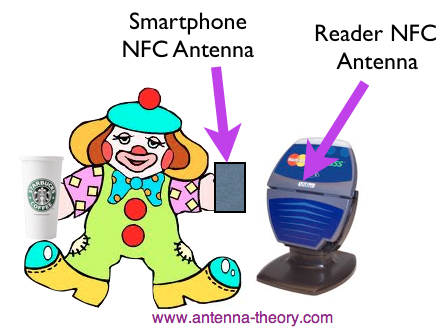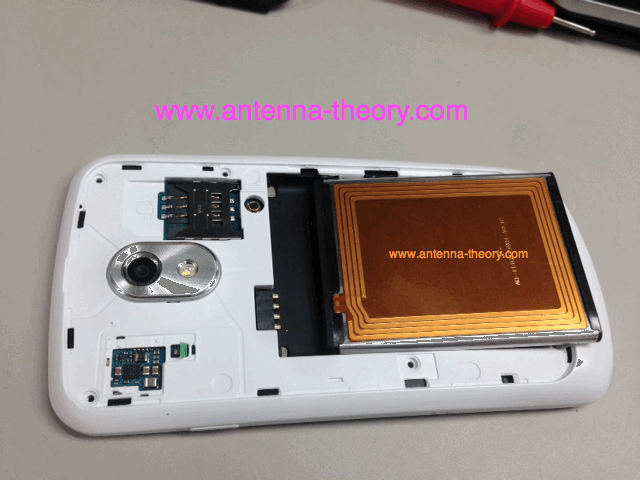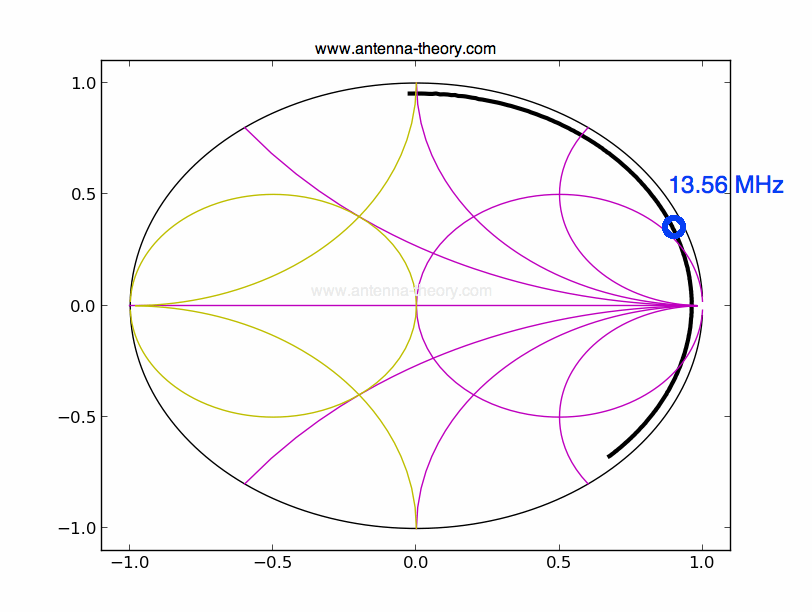
Antenna Theory .com Antenna Definitions
How do NFC antennas work? This page will discuss that in a simple manner. We'll try to explain why NFC antennas aren't really antennas at all (like the dipole antenna or the Horn Antenna). But first, let's give some background on NFC.
NFC stands for Near Field Communications and goes by the acronym NFC. NFC is simply a set of standards for smartphones or whatever to establish communication with each other by bringing them into close together (typically 0-5 centimeters). This set of standards is just like 802.11b or 802.11n for WIFI - it sets the protocols to send and receive information. The application of NFC include swiped proximity payments (such as google wallet for paying at Starbucks), information exchange at small distances (for instance, touching smartphones to share contact information), and simplified setup of devices such as Wi-Fi or Bluetooth. Communication is also possible between an NFC device and an unpowered NFC chip, called a tag (as in RFID tag).
So NFC is just a method of communication between two devices at short distance. What makes the NFC antenna design simple or easy? If you know much about antennas, the first question you might ask is what is the operating frequency of NFC. It turns out that these devices operate around 13.56 MHz. The corresponding wavelength is 22 meters long - this means to get a nice half-wave dipole antenna (that radiates well) we would need a device about 11 meters in length.
Now, clearly we have NFC antennas on smartphones or there would be no Google Wallet, for instance. So the challenge in NFC antenna design is to obtain a "radiating" structure when the NFC antenna area may be limited to 3"x1" (or 7 cm * 2.5 cm). Hence, we are talking about fitting an antenna into a volume where the maximum linear dimension is about 0.5% or less of a wavelength. And from antenna theory, we know that you won't get any radiation out of such a small device.
To sum up the discussion so far: NFC antennas operate at low frequency (large wavelengths) on small devices. A consequence of this is that the radiation efficiency of an NFC antenna will be about 0.
Therefore, NFC antennas are not really antennas, in that no one cares about typical antenna parameters, such as the radiation pattern or the antenna gain. So how then do they work?
You may recall from your electric circuits classes that inductors can be made to couple together - that is, there exists mutual coupling. If the magnetic fields from one inductor pass near another inductor, an induced current will exist within the second inductor. This is contactless energy transfer - exactly what NFC requires.
Hence, an NFC antenna isn't an antenna at all - it is really just a big inductor. In general, the larger the inductance of the antenna can be made, the better it will perform. Note that this doesn't mean you can place a very small chip inductor as your NFC antenna - the magnetic fields on these inductors are tightly wound and don't extend much beyond the chips themselves. Rather, a good NFC antenna is as large of a wrapped coil of wire as possible. Recall that a loop of wire around a material gives a strong magnetic field within the loop (and generally the more turns you have the more inductance you create). Hence, NFC antennas are often simply loops of wire, occupying as much surface area as the device allows.
Here's a simple little diagram of an NFC transaction at starbucks by some clown with a Google Nexus Smartphone with NFC:

The corresponding circuit diagram is given in Figure 2:

In Figures 1 and 2, the NFC reader excites current at 13.56 MHz through the reader NFC antenna (which is really an inductor). This induces a magnetic field, which furthur (via mutual coupling) induces an electric current in the smartphone's NFC antenna when they are closely placed. This induced electric current can be read, and we have communication. This is exactly what is happening when it comes to NFC communication in practice, with the focus on the antennas.
One final note related to NFC antenna design. We've already stated that the larger the surface area, the better performing your NFC antenna will be. We haven't mentioned anything about volume. Can the NFC antenna be infinitely thin? The answer is yes - if there is no metal or conductive material around the NFC antenna. However, the NFC antenna illustrated in Figure 1 is on the back of a smartphone, which is metallic. If you know much about electromagnetics, you will know that a ground plane directly beneath magnetic or electric fields will very much degrade them. Hence, performance degrades for the NFC inductor style antenna when placed near a metallic surface. As a result, for performance the height of the NFC loop will need maximized. If the space is near zero, the performance will suffer.
One small trick to get around this is to use high permeability sheets (ferrite, iron based, whatever) between the NFC antenna and the metallic ground plane. This serves to concentrate the magnetic fields, effectively making them think the distance is larger between the NFC antenna and the ground plane. This helps to alleviate the height problem, but does not eliminate it.
Enough with the pleasantries, let us look at an actual NFC antenna on the Samsung Nexus phone by Google. It is located on the back of the battery which is on the back of the device under a thin plastic cover:

As you can see, the NFC antenna is literally just a big loop. Now, if we cable up to the nfc antenna and measure S11 on the Smith Chart with a Vector Network Analyzer (VNA), we get the result in Figure 4:

The blue circle is where the frequency is 13.56 MHz, and at this point the value of the inductance can be measured: for this antenna it is 3.6 uH (microHenries - this is 3.6*10^-6 Henries). This is important, because it gives you an idea of how much inductance you need for an NFC antenna. There are no rules of thumb, but generally you want at least 1 uH of inductance for an NFC antenna. This rule is sometimes ignored; for example in iPhones, the NFC antenna is usually part of the metal bezel (metal ring) that makes up the device's chasis. In this case, they use a loop that is made up of the structure itself, which will have low inductance.
For NFC transmit antennas, they are often matched to 35-50 Ohms. This is usually called out in the NFC chipset's spec sheet. The impedance strongly determines how much power the antenna pulls (and the corresponding strength of its magnetic field). Because the output of the chipset is often a square wave of some defined voltage level (say 3.3 or 5V), the current flow is simply equal to the voltage divided by the impedance (e.g. 50 Ohms). By lowering the antenna impedance, more current will flow through the coil, at the expense of more current draw for the NFC system.
NFC is also used in NFC tags, which are embedded within access badges, Apple AirTags, hotel keys and credit cards. In this case, the impedance is usually matched to an open circuit (or very high impedance, such as 2 kOhms). By doing this, the induced voltage at the chipset is maximized, since very little current is required for powering the tag chipsets (<1mA). Often, the tag will have an associated capacitance defined in its spec sheet, and the ideal value for the inductance of the NFC coil (antenna) is such that the resonant combination of the capacitance and the NFC coil is an open circuit at 13.56MHz. In this way, no additional impedance matching components are needed.
Qi charging and NFC have a lot in common. One main difference is Qi charging operates in the 100-200kHz range, which is much lower than that of NFC. Qi charging coils also are not used for data transfer as in the case of NFC. Qi charging are able to handle larger levels of power delivery than NFC [Qi charging can charge phones and tablets; NFC is limited to charging devices like a tablet/phone stylus].
Qi charging coils typically use a ferrite material (silicon steel or Manganese Zinc) to shield the coil from any metal behind the coil. They also often use Litz wire, which is a type of wire with a higher inductance per unit length than a corresponding wire with the same resistance. This helps to maximize power transfer.
This concludes our discussion of NFC antennas and some of the basics in NFC antenna design. As you can see, this is a very atypical antenna, and really I don't classify it as an antenna at all. Peace!
Antenna Tutorial
Top: NFC Antennas
This page on NFC antennas is copyrighted. No portion can be reproduced except by author's permission. Copyright 2009-2024 antenna-theory.com. Near field communication antenna.